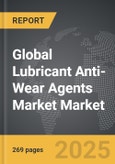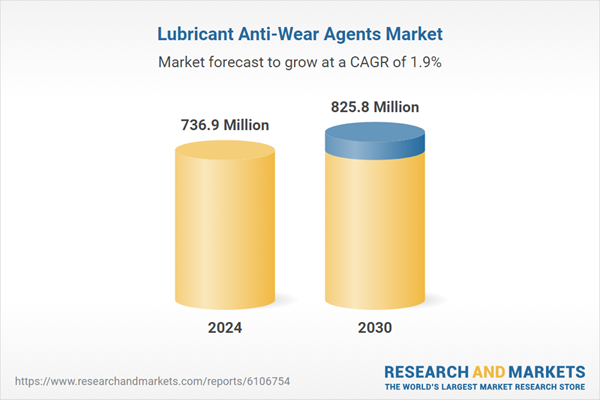Global Lubricant Anti-Wear Agents Market - Key Trends & Drivers Summarized
Why Are Lubricant Anti-Wear Agents Critical in Enhancing the Performance and Lifespan of Machinery?
Lubricant anti-wear agents are indispensable additives in the formulation of high-performance lubricants, playing a vital role in reducing friction, preventing metal-to-metal contact, and extending the service life of mechanical components. These agents function by forming a protective film over surfaces under high load or stress, thus minimizing abrasion and surface degradation. In industries where equipment operates under extreme pressures or temperatures, such as automotive, aerospace, manufacturing, and construction, the absence of effective anti-wear chemistry can lead to significant downtime, costly repairs, and operational inefficiencies. The increasing sophistication of machinery and tighter engineering tolerances mean that even minor surface wear can result in decreased performance or complete system failure. As a result, anti-wear agents such as zinc dialkyldithiophosphate (ZDDP), phosphates, esters, and molybdenum compounds have become standard in lubricant formulations. These compounds are engineered to perform consistently under varying conditions, including high-speed, high-load, and corrosive environments. In automotive engines, for example, anti-wear agents protect vital parts like camshafts and pistons during startup and prolonged operation. In hydraulic systems, they ensure smooth valve operation and pump efficiency. Their role is not limited to protection but also contributes to overall fuel economy and emissions reduction by maintaining optimal engine and system efficiency. With global machinery becoming more advanced and subjected to higher operational demands, lubricant anti-wear agents are increasingly viewed as essential for sustainable and reliable equipment performance.How Are Technological Innovations Advancing the Formulation of Next-Generation Anti-Wear Agents?
Advancements in materials science and chemical engineering are significantly enhancing the development of next-generation anti-wear agents that offer superior protection while meeting increasingly strict environmental and performance standards. Traditional additives like ZDDP have long been favored for their cost-effectiveness and proven performance, but their phosphorus and sulfur content can lead to catalyst poisoning and higher emissions in internal combustion engines. This has prompted a wave of innovation aimed at developing ashless, non-toxic, and more thermally stable alternatives. New compounds based on boron, nitrogen, and organomolybdenum chemistry are being synthesized to deliver comparable or superior wear protection with reduced environmental impact. Nanotechnology is also entering the field, with nanoparticles such as graphene, boron nitride, and molybdenum disulfide showing promise in reducing wear at the microscopic level while enhancing lubricant thermal conductivity. These particles can self-assemble into protective tribofilms, offering dynamic responses to changing pressure and temperature. Synthetic esters and ionic liquids are being studied for use as base oils or co-additives that can further amplify the effects of anti-wear agents. Research is also focusing on synergistic additive packages that combine friction modifiers, anti-oxidants, and anti-wear agents to optimize performance across a broader range of applications. These innovations are particularly relevant for electric vehicles, high-speed turbines, and other modern equipment where traditional lubrication solutions fall short. As testing methodologies and computational modeling techniques improve, manufacturers are gaining deeper insight into molecular interactions, enabling more targeted and efficient formulation strategies that keep pace with evolving industry requirements.What Market and Industry Trends Are Influencing the Demand for Lubricant Anti-Wear Agents?
The global demand for lubricant anti-wear agents is being shaped by a convergence of industry trends, shifting performance expectations, and regulatory developments aimed at sustainability and efficiency. One of the most prominent trends is the rapid advancement of automotive technologies, including the transition to hybrid and electric powertrains. Although electric vehicles may use fewer engine lubricants, they still require high-performance gear oils and thermal management fluids containing anti-wear agents to protect components such as bearings and e-axles. Meanwhile, traditional internal combustion engine vehicles continue to evolve, with higher engine loads, smaller designs, and turbocharging creating more intense lubrication environments. The industrial sector is also a significant driver, as advanced manufacturing equipment, robotics, and automated systems operate at higher speeds and pressures, increasing reliance on precision lubrication. In heavy machinery and off-road equipment, where equipment failure can lead to substantial productivity losses, anti-wear agents are viewed as a critical line of defense. Regulatory pressures around emissions and sustainability are encouraging lubricant manufacturers to develop environmentally acceptable lubricants (EALs) that include biodegradable anti-wear agents. Consumer awareness of energy conservation and maintenance costs is another influential factor, as end-users seek lubricants that can extend service intervals and reduce equipment wear over time. The increasing complexity of supply chains and the global push for product standardization are prompting formulation consistency and greater R&D investment in additive chemistry. These market forces are collectively reinforcing the importance of anti-wear agents as essential components in both traditional and emerging lubrication systems.What Factors Are Driving the Global Growth of the Lubricant Anti-Wear Agents Market?
The growth in the global lubricant anti-wear agents market is being driven by several interrelated factors rooted in technological progress, industrial expansion, environmental compliance, and rising awareness of maintenance optimization. One of the foremost drivers is the increasing demand for advanced lubricants across automotive, aerospace, energy, and heavy machinery industries, all of which require reliable wear protection to ensure long-term performance. The global expansion of industrial manufacturing, particularly in Asia-Pacific and Latin America, is creating new demand for specialty lubricants that incorporate high-performance additive packages including anti-wear agents. As equipment becomes more sophisticated and capital-intensive, operators are prioritizing preventive maintenance, which in turn boosts the demand for lubricants that extend component life and minimize downtime. Stricter environmental regulations are compelling lubricant producers to reformulate products to meet reduced phosphorus and sulfur content limits, resulting in the development and adoption of new eco-friendly anti-wear technologies. Technological innovation is also enabling the customization of additive blends for niche applications, such as wind turbines, marine engines, and biodegradable hydraulic systems, further expanding the market. The growth of electric mobility and the associated demand for non-combustion lubrication systems is opening new frontiers for anti-wear chemistry that meets different thermal and operational demands. Increasing collaboration between lubricant manufacturers, OEMs, and additive developers is facilitating faster innovation cycles and broader product adoption. Digitalization and condition monitoring technologies are helping users track lubricant performance in real time, highlighting the importance of robust anti-wear agents in data-driven maintenance programs. All these factors collectively are driving the steady and sustained expansion of the lubricant anti-wear agents market on a global scale.Report Scope
The report analyzes the Lubricant Anti-Wear Agents market, presented in terms of market value (US$). The analysis covers the key segments and geographic regions outlined below:- Segments: Agent (Zinc Dialkyl Di-Thiophosphate Agent, Phosphate Agent, Phosphite Agent, Phosphonate Agent); Distribution Channel (Captive Distribution Channel, Merchant Distribution Channel).
- Geographic Regions/Countries: World; United States; Canada; Japan; China; Europe (France; Germany; Italy; United Kingdom; Spain; Russia; and Rest of Europe); Asia-Pacific (Australia; India; South Korea; and Rest of Asia-Pacific); Latin America (Argentina; Brazil; Mexico; and Rest of Latin America); Middle East (Iran; Israel; Saudi Arabia; United Arab Emirates; and Rest of Middle East); and Africa.
Key Insights:
- Market Growth: Understand the significant growth trajectory of the Zinc Dialkyl Di-Thiophosphate Agent segment, which is expected to reach US$349.1 Million by 2030 with a CAGR of a 1.5%. The Phosphate Agent segment is also set to grow at 1.6% CAGR over the analysis period.
- Regional Analysis: Gain insights into the U.S. market, valued at $200.8 Million in 2024, and China, forecasted to grow at an impressive 3.5% CAGR to reach $152.5 Million by 2030. Discover growth trends in other key regions, including Japan, Canada, Germany, and the Asia-Pacific.
Why You Should Buy This Report:
- Detailed Market Analysis: Access a thorough analysis of the Global Lubricant Anti-Wear Agents Market, covering all major geographic regions and market segments.
- Competitive Insights: Get an overview of the competitive landscape, including the market presence of major players across different geographies.
- Future Trends and Drivers: Understand the key trends and drivers shaping the future of the Global Lubricant Anti-Wear Agents Market.
- Actionable Insights: Benefit from actionable insights that can help you identify new revenue opportunities and make strategic business decisions.
Key Questions Answered:
- How is the Global Lubricant Anti-Wear Agents Market expected to evolve by 2030?
- What are the main drivers and restraints affecting the market?
- Which market segments will grow the most over the forecast period?
- How will market shares for different regions and segments change by 2030?
- Who are the leading players in the market, and what are their prospects?
Report Features:
- Comprehensive Market Data: Independent analysis of annual sales and market forecasts in US$ Million from 2024 to 2030.
- In-Depth Regional Analysis: Detailed insights into key markets, including the U.S., China, Japan, Canada, Europe, Asia-Pacific, Latin America, Middle East, and Africa.
- Company Profiles: Coverage of players such as ArcelorMittal S.A., BASF SE, Binderholz GmbH, CarbonCure Technologies Inc., CEMEX S.A.B. de C.V. and more.
- Complimentary Updates: Receive free report updates for one year to keep you informed of the latest market developments.
Some of the 32 companies featured in this Lubricant Anti-Wear Agents market report include:
- Afton Chemical Corporation
- BASF?SE
- Chevron Oronite Company?LLC
- Clariant AG
- Croda International Plc
- Dow Chemical Company
- Eni?S.p.A.
- Evonik Industries AG
- Fuchs SE
- Henkel AG?&?Co.?KGaA
- Idemitsu Kosan Co. Ltd.
- Infineum International Ltd.
- Nynas AB
- Quaker Houghton (Quaker Chemical)
- Royal Dutch Shell plc
- SK Innovation
- Tianhe Chemicals Group Ltd.
- The Lubrizol Corporation
- Vanderbilt Chemicals, LLC
- Xado
This edition integrates the latest global trade and economic shifts into comprehensive market analysis. Key updates include:
- Tariff and Trade Impact: Insights into global tariff negotiations across 180+ countries, with analysis of supply chain turbulence, sourcing disruptions, and geographic realignment. Special focus on 2025 as a pivotal year for trade tensions, including updated perspectives on the Trump-era tariffs.
- Adjusted Forecasts and Analytics: Revised global and regional market forecasts through 2030, incorporating tariff effects, economic uncertainty, and structural changes in globalization. Includes historical analysis from 2015 to 2023.
- Strategic Market Dynamics: Evaluation of revised market prospects, regional outlooks, and key economic indicators such as population and urbanization trends.
- Innovation & Technology Trends: Latest developments in product and process innovation, emerging technologies, and key industry drivers shaping the competitive landscape.
- Competitive Intelligence: Updated global market share estimates for 2025, competitive positioning of major players (Strong/Active/Niche/Trivial), and refined focus on leading global brands and core players.
- Expert Insight & Commentary: Strategic analysis from economists, trade experts, and domain specialists to contextualize market shifts and identify emerging opportunities.
Table of Contents
Companies Mentioned (Partial List)
A selection of companies mentioned in this report includes, but is not limited to:
- Afton Chemical Corporation
- BASF?SE
- Chevron Oronite Company?LLC
- Clariant AG
- Croda International Plc
- Dow Chemical Company
- Eni?S.p.A.
- Evonik Industries AG
- Fuchs SE
- Henkel AG?&?Co.?KGaA
- Idemitsu Kosan Co. Ltd.
- Infineum International Ltd.
- Nynas AB
- Quaker Houghton (Quaker Chemical)
- Royal Dutch Shell plc
- SK Innovation
- Tianhe Chemicals Group Ltd.
- The Lubrizol Corporation
- Vanderbilt Chemicals, LLC
- Xado
Table Information
| Report Attribute | Details |
|---|---|
| No. of Pages | 269 |
| Published | November 2025 |
| Forecast Period | 2024 - 2030 |
| Estimated Market Value ( USD | $ 736.9 Million |
| Forecasted Market Value ( USD | $ 825.8 Million |
| Compound Annual Growth Rate | 1.9% |
| Regions Covered | Global |









